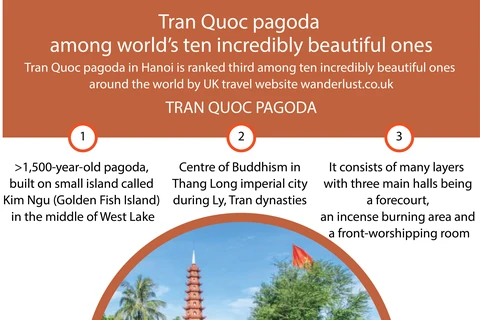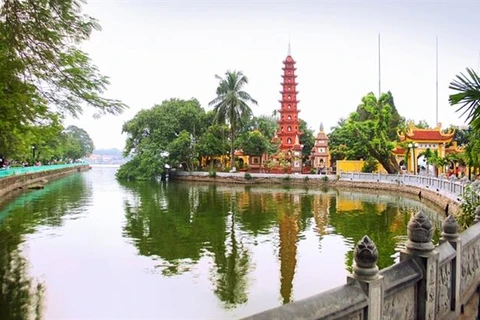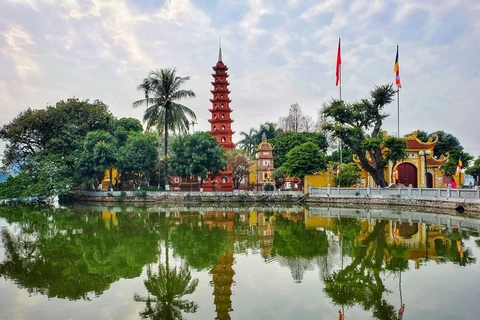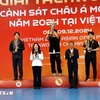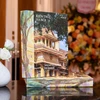 Situated on the east side of West Lake, Tran Quoc Pagoda is the oldest Buddhist temple in the capital city of Hanoi, which dates back to the 6th century. (Photo: Vietnam Pictorial)
Situated on the east side of West Lake, Tran Quoc Pagoda is the oldest Buddhist temple in the capital city of Hanoi, which dates back to the 6th century. (Photo: Vietnam Pictorial) Hanoi (VNA) – Situated on the east side of West Lake, Tran Quoc Pagoda – a landmark in Hanoi – is the oldest Buddhist temple in the capital city, dating back to the 6th century.
The temple is about 1,500 years old and epitomises a spiritual sanctuary for its citizens, where they wish for peace and fortune. However, it is not just a place of worship. The Tran Quoc Pagoda also attracts visitors for its cultural background and symbolic architecture.
The pagoda was built between 541 – 547 during the reign of King Ly Nam De, in Yen Hoa village near the bank of the Hong (Red) River. Back then, it bore the name Khai Quoc Pagoda (Khai Quoc means Founding a Nation), which was later changed to An Quoc (Pacification of the Realm) during the reign of King Le Thai Tong (1434 – 1442).
After a landslide on the river bank crumbled the foundation of the pagoda, it was moved to the current location by King Le Hy Tong in the early 17th century, when its name finally settled as Tran Quoc (National Defence), as a prayer for peace, happiness and protection from natural disasters.
It used to be the capital of Buddhism in the Thang Long Imperial Citadel and was favoured by kings of the Ly and Tran Dynasties as a place for sightseeing and worshipping during festivals and special occasions.
The Tran Quoc Pagoda is famous not only for its history but also for its architecture and stunning scenery.
As a symbol of Buddhism, the Tran Quoc Pagoda’s design strictly follows its architectural principles, with layers of building and three main houses – Tien Duong (front house), Thuong Dien (upper house) and Nha Thieu Huong (incense burning house) – lined up to form a Cong script (工).
In 2016, it was named one of the world’s 16 most beautiful pagodas by the Daily Mail, a British tabloid newspaper. It was also listed as one of the world’s most beautiful Buddhist pagodas by US magazine National Geographic in 2019.
According to National Geographic, the Tran Quoc Pagoda floats on a tiny island in West Lake. The pagoda features an 11-story red stupa topped by a nine-story gemstone lotus. Gold and bronze statues clutter altars throughout the pagoda, and three different female Buddhas, called “Mothers,” can be found in Tran Quoc’s front courtyard.
The 15-metre tall stupa called Bao Thap was built in 1998. Each of its floors consists of six vaulted windows and a statue of Amitabha.
Adding to the architectural beauty and historical significance of the pagoda is a Bodhi tree, said to be the "offspring" of the original tree under which the Buddha attained enlightenment in India 25 centuries ago. The bodhi tree was presented to the Tran Quoc Pagoda by the then Indian President Rajendra Prasad when he visited Hanoi in 1959.
The Tran Quoc Pagoda is also known to tourists for exhibiting a precious antique collection. Dating back hundreds of years ago, the objects are meticulously crafted, showcasing the excellent skill of craftsmanship.
They are still in good condition today thanks to the preservation efforts of the government. The majority of the collection is on display in the upper house. The most noteworthy piece is the Shakyamuni Buddha statue, which is highly regarded as one of the most beautiful Nirvana statues in Vietnam.
The Tran Quoc Pagoda is endorsed by devotees as a sacred worshipping sanctuary, where they go to pray and wish for peacefulness, fortune, and happiness.
Often, people visit the Tran Quoc Pagoda to find serenity in the mind. The tranquil atmosphere at the temple makes it a perfect place for busy minds to relax and rest, especially after a long working day./.


